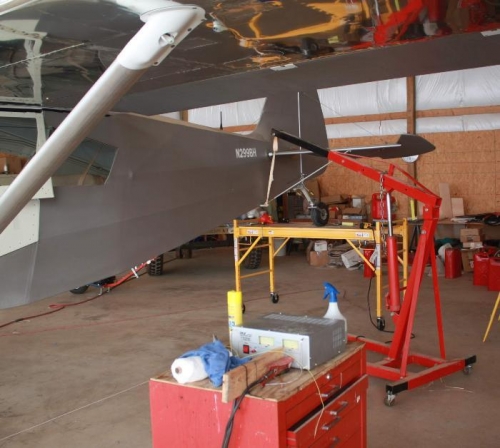
|

|
|

|
Ron's Web Site

|
Date: 1-1-2011
|
Number of Hours: 12.20
|
Manual Reference:
|
Brief Description: Fuel Tank Calibration
|

|
I calibrated the fuel tanks. Since I don't have a fuel source other than 6 jerry cans, it was necessary to pour the fuel into a smaller, two gallon can which was more easily handled for pouring into the fuel tanks. I weighed the 2 gallon can with fuel in it and then after it was emptied for each increment, calculating the gallons of fuel from the difference in weight. It was also necessary to calibrate the fuel levels in the tail-low or ground position and in the level flight position. I hit upon the idea of using an engine lift pull the tail up. I first filled the aux tanks two gallons at a time and raised and lowered the tail and input the A/D (analog/digital) values into the EFIS. I probably started out with the wrong zero, though, as I zeroed the aux tanks after pumping all the fuel out in the ground attitude. Since the tank outlet is relatively forward, there is probably more unuseable fuel in that configuration than what would be pumped out in the level flight configuration. As a result, I ended up with only 6.9 gallons each of useable fuel in the aux tanks.
After calibrating the aux tanks, I siphoned the fuel back into the 5 gallon jerry cans, and performed the same actions on the main tanks. I first did the right tank, siphoned the fuel back into the jerry cans, then accomplished the same thing on the left tank. Along the way, I discovered a missing fuel bung plug and a binding fuel sender, which required adjustment. It's also helpful to have the fuel selecton "off", when trying to fill one tank. I also made a main tank dipstick for manually checking the fuel level. It takes about 8 gallons before fuel is visible in the fuel fillers. Also, the tanks should only be filled to the bottom of the filler necks, as the fuel comes forward when the tail is lifted.
Finally, I measured the actual arm of the main and aux tanks, using the wing leading edge as the datum, and the fore-aft center of the tank as the arm. The main tank average arm is 26.3 inches and the aux tank average arm is 29.6 in
|

|

Regulated power supply, engine lift, gas can and digital scale.
|

|
|

|

|

|
|

|

|
Copyright © 2001-2024 Matronics. All Rights Reserved.
|

